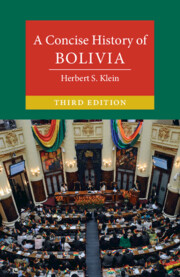Book contents
- A Concise History of Bolivia, Third Edition
- Cambridge Concise Histories
- A Concise History of Bolivia Third Edition
- Copyright page
- Contents
- Preface to the Third Edition
- Preface to the Second Edition
- Preface to the First Edition
- Chapter 1 Geography and Pre-Columbian Civilization
- Chapter 2 The Creation of a Colonial Society
- Chapter 3 Late Colonial Society: Crisis and Growth
- Chapter 4 Revolution and the Creation of a Nation-State, 1809–1841
- Chapter 5 The Crisis of the State, 1841–1880
- Chapter 6 The Ages of Silver and Tin, 1880–1932
- Chapter 7 Disintegration of the Established Order, 1932–1952
- Chapter 8 From the National Revolution to the Cold War, 1952–1982
- Chapter 9 Creating a Multiethnic Democracy, 1982–2002
- Chapter 10 The Emergence of a Mestizo and Indigenous Elite
- Political Chronology
- Tables
- Bibliography
- Index
Chapter 1 - Geography and Pre-Columbian Civilization
Published online by Cambridge University Press: 02 December 2021
- A Concise History of Bolivia, Third Edition
- Cambridge Concise Histories
- A Concise History of Bolivia Third Edition
- Copyright page
- Contents
- Preface to the Third Edition
- Preface to the Second Edition
- Preface to the First Edition
- Chapter 1 Geography and Pre-Columbian Civilization
- Chapter 2 The Creation of a Colonial Society
- Chapter 3 Late Colonial Society: Crisis and Growth
- Chapter 4 Revolution and the Creation of a Nation-State, 1809–1841
- Chapter 5 The Crisis of the State, 1841–1880
- Chapter 6 The Ages of Silver and Tin, 1880–1932
- Chapter 7 Disintegration of the Established Order, 1932–1952
- Chapter 8 From the National Revolution to the Cold War, 1952–1982
- Chapter 9 Creating a Multiethnic Democracy, 1982–2002
- Chapter 10 The Emergence of a Mestizo and Indigenous Elite
- Political Chronology
- Tables
- Bibliography
- Index
Summary
Bolivian society evolved in a highly complex and unusual environment. Although situated in tropical latitudes, it was in fact an unusual high altitude society only comparable to those few similar societies found in the Himalayas. From the earliest human settlement to the present day, a good part of its people have lived at altitudes over five thousand feet above sea level, with the majority of the population and its most advanced cultures being found at twelve thousand feet or above. While not a totally prohibitive environment, the highlands have poorer soils and much colder and drier climates, and face constraints that do not hinder the lowlands. This ecology required the domestication of plants and animals unique to the highlands and even had a dramatic impact on human physiology, as highland populations were forced to adapt to the limited supply of oxygen and quite different degrees of air pressure.
- Type
- Chapter
- Information
- A Concise History of Bolivia , pp. 1 - 23Publisher: Cambridge University PressPrint publication year: 2021

